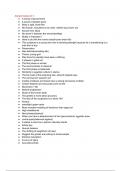Class notes
Ancient Greek Art
- Institution
- St. Francis College
Why Choose My Notes? Thoroughly Researched: My notes cover key concepts, definitions, and examples, ensuring you grasp the material thoroughly. Easy to Understand: Each topic is broken down into clear, concise explanations, making complex ideas accessible. Exam-Ready: Tailored to align with your...
[Show more]



